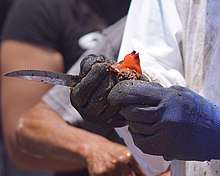Pyura chilensis
Pyura chilensis, called piure in Spanish, is a tunicate of the family Pyuridae. It was described in 1782 by Juan Ignacio Molina.[1]
| Pyura chilensis | |
|---|---|
 | |
| Piure on a bed of clams, harvested in the Valparaíso Region | |
| Scientific classification | |
| Kingdom: | |
| Phylum: | |
| Subphylum: | |
| Class: | |
| Order: | |
| Suborder: | |
| Family: | |
| Genus: | |
| Species: | P. chilensis |
| Binomial name | |
| Pyura chilensis (Molina, 1782) | |
Description
Pyura chilensis is a tunicate that somewhat resembles a mass of organs inside a rock. It is often found in dense aggregations in the intertidal and subtidal coast of Chile and Peru. It is a filter feeder that eats by sucking in seawater and filtering out microorganisms.
P. chilensis has some basic characteristics common to chordates, such as the notochord and a perforated pharynx. It is born male, becomes hermaphroditic at puberty, and reproduces by tossing clouds of sperm and eggs into the surrounding water. If it is alone, it will procreate by self-fertilization.[2]
Its blood is clear and can contain high concentrations of vanadium, which may be ten million times that found in surrounding seawater, although the source and function of this element's concentrations are unknown.[3]
History
The earliest mention of the P. chilensis was in 1782 by Juan Ignacio Molina in his book "Saggio Sulla Storia Naturale del Chili." Molina, a Chilean abbot who was shunned from Chile along with the rest of the Jesuit missionaries, wrote this book to describe the life lived by the Chileans in the Chiloe Archipelago.[4] He briefly describes the natives' fondness of fishing and mentions the piure as another form of sustenance for the people.[5]
Fishery
On the Chilean coast, banks of P. chilensis are heavily fished.[6] The animal is also one of the main food sources for other local aquatic species such as the Chilean abalone (Concholepas concholepas), whose proliferation has threatened P. chilensis and severely restricted its growth for more than two decades.
Many locals don wet suits and goggles to gather the delicacy, mostly in rocky areas close to shore, but occasionally farther out to sea.

Fishermen typically cut P. chilensis into slices with a handsaw, then use their fingers to pull out the siphons (which they refer to as tetas, or "tits") from the carapace, which is discarded. The flesh is usually sold in strips, but may be canned. It is exported to numerous countries, including, as of 2007, Sweden (32.5% of exports) and Japan (24.2%).[7]
Cuisine
The meat, which has a strong flavor, can be eaten raw or cooked. Its taste has been described as like that of iodine[8] or "something like a sea urchin though less delicate in flavor" and a "slightly bitter, soapy taste".[9] It is usually cut into small pieces, and flavored with chopped onion, cilantro, and lemon. Minced and boiled, it serves as an element of many dishes, particularly arroz con piure picado, or "rice with minced piure". It can also be fried and eaten on bread. A similar edible tunicate in the Mediterranean is Microcosmus sabatieri, also called a sea violet or sea fig.[10]
There are concerns about the safety of eating P. chilensis, given its high concentration of vanadium, with up to 1.9 mg/kg found in dry blood plasma.[11] Vanadium is a heavy metal, considered toxic at any more than incidental levels.[12] The average diet provides trace amounts of vanadium; typically 6–18 micrograms (µg).[13] According to the University of Maryland Medical Center, vanadium can cause liver damage in high doses of 1.8 mg or more daily.[13] No in-depth studies have been done to determine the amount of vanadium contained within the blood or tissue of P. chilensis, nor in typical dishes containing its flesh.
References
- "WoRMS taxon details—Pyura chilensis Molina, 1782". World Register of Marine Species. Retrieved 1 July 2012.
- Patricio H. Manríquez; Juan Carlos Castilla (2005). "Self-fertilization as an alternative mode of reproduction in the solitary tunicate Pyura chilensis" (PDF). Marine Ecology Progress Series. 305: 113–125. Bibcode:2005MEPS..305..113M. doi:10.3354/meps305113. Archived from the original (PDF) on 2007-06-23. Retrieved 2013-07-10.
- Crew, Becky (21 June 2012). "Pyura chilensis: the closest thing to getting blood from a stone" ("Running Ponies" web log). Scientific American. Retrieved 13 July 2013.
- "Juan Ignacio Molina Abate". www.profesorenlinea.cl (in Spanish).
- Juan Ignacio Molina (1808). The Geographical, Natural, and Civil History of Chili. Middletown, (Conn.) : printed for I. Riley.
- Andrew R. Davis (1995). "Over-exp loitation of Pyura chilensis (Ascidiacea) in southern Chile: the urgent need to establish marine reserves" (PDF). Revista Chilena de Historia Natural.
- Tapia Jopia, Carlos; Toledo, Nancy Barahona (February 2007). "Pesquería de Pyura chilensis (Molina 1782) (Tunicata, Ascidiacea, Pyuridae)". Investigación Situación Pesquerías Bentónicas, 2006 (in Spanish): ii. hdl:1834/3110.
- "Larval Metamorphosis: Piure heaven". larvalmetamorphosis.com. Archived from the original on 17 January 2012. Retrieved 10 March 2018.
- Beckett, Fiona (21 April 2010). "Food & Wine Finds: Piure: the world's strangest seafood?". foodandwinefinds.blogspot.com. Archived from the original on 18 January 2018. Retrieved 10 March 2018.
- cf. Ascidiacea#Culinary
- Roman, Domingo A.; Molina, Justa; Rivera, Lidia (1988). "Inorganic Aspects of the Blood Chemistry of Ascidians. Ionic Composition, and Ti, V, and Fe in the Blood Plasma of Pyura chilensis and Ascidia dispar". Biol. Bull. 175 (1): 154–166. doi:10.2307/1541903. JSTOR 1541903.
- "Occupational Safety and Health Guideline for Vanadium Pentoxide Dust". www.osha.gov. Archived from the original on May 3, 2013. Retrieved March 22, 2015.
- "Vanadium". University of Maryland Medical Center. Retrieved 10 March 2018.